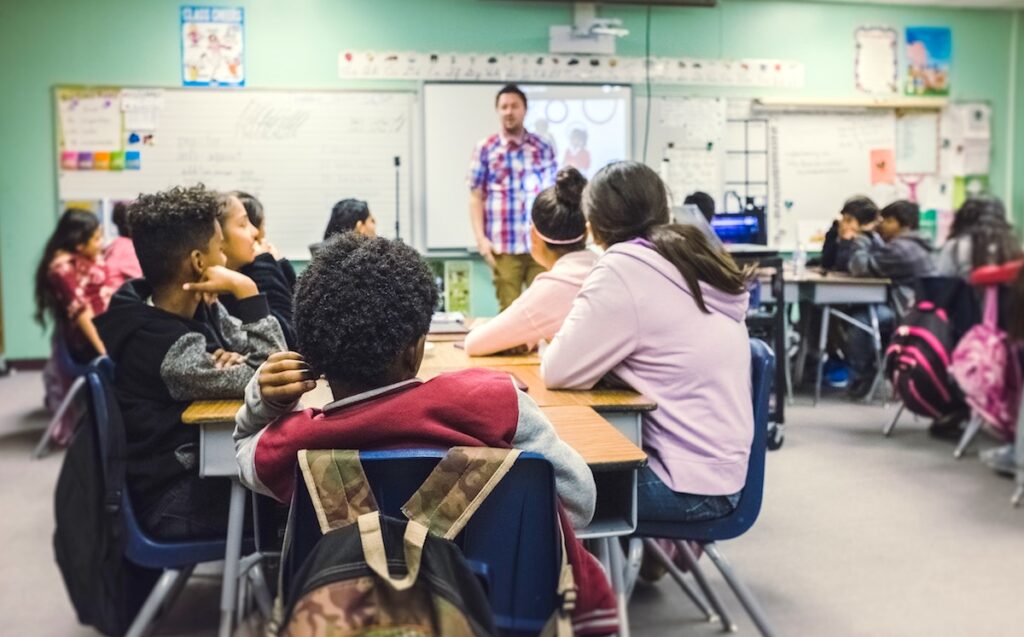Do you review the syllabus, rules, and procedures on the first day of school? Many teachers do.
It’s important to make sure students understand the rules and expectations from the start. But, it doesn’t have to happen through reading a syllabus and giving a quiz. Instead, do something different and set yourself apart from the crowd. Teach students through creating and communicating.
From day one, teach students how to think like an artist.
Let’s look at what that means. Here are a few things artists do.
- Artists make choices.
- Artists experiment.
- Artists take risks.
- Artists push boundaries.
- Artists fail.
Start to get students thinking in these ways with your first day procedures.

In the high school art room, students often have to make choices about which medium to use or subject matter they wish to explore. Beginning on day one, have your students learn to make both big and small choices. One easy way to do this is by allowing students to choose their own seats.
If you like having a seating chart because it helps you to learn students’ names, start by allowing students to select their seats, then create your chart. You can also tell students they need to sit in the same seats when they have a substitute.
You’ll find students are creatures of habit and they’ll naturally end up sitting in the same seats every day.
Next, surprise your students.
Instead of telling students the rules, have them uncover them through creating. Or have them create the rules themselves.
If you decide you want to have students create art on day one, here’s an idea for you.
Split students into groups of four, telling them they have one class period to create the tallest tower possible that also has the most negative space. Give each group fifteen sheets of scrap paper and fifteen pieces of masking tape. Limit students to the supplies provided.
You’ll find most students aren’t sure what negative space is, making this the perfect time for them to begin to learn how to help themselves and do some research. Resisting the natural urge to answer every question will reinforce student independence and resourcefulness. Guide them by asking questions. Through this activity, students will learn to work together and problem solve.
As students build their towers, move throughout the room demonstrating your behavioral expectations.
Use the last fifteen minutes to have students share the processes they used and why they feel they’ve best demonstrated negative space. Here, students learn about the practice of self-reflection. If you have time, you could also incorporate a critique.
Ask questions like:
- How did you determine your process for building your tower?
- Did anyone in your group take the lead? How did that work?
- Looking at other groups’ towers, is there anything you would do differently if you were to do this again?
- What tools would have made this assignment easier?
- Have groups write a 6-word story about their tower as closure, getting them into the practice of writing about their work.
If you want your students to come up with the art room rules, try this method.
Giving students ownership of the classroom rules is a powerful classroom management tool.
1. Start by telling students all classrooms run better if there are agreed upon expectations for both the students and teacher.
Break students into groups and have them brainstorm rules and expectations. Have students create a list of both for themselves and for you. You might be surprised at how easily high school students will come up with rules and expectations for themselves.
However, having rules and expectations for you, the teacher is often a new concept, so students may need a bit more encouragement or a few examples.
For example, if you expect students to take their work seriously, then you, as the teacher, should promise to provide timely relevant feedback and support.
Another example I share with my students is about getting to class on time. At my first position, I had two classrooms at opposite ends of the building. I was often switching classes along with students and didn’t always make it to class before the bell rang. It didn’t seem fair to penalize students for being late when sometimes I was going to be late. We agreed we all needed to make our best effort to make it to class on time. We agreed we would be patient with each other if every once in awhile we were a minute or two late.

2. After groups finish brainstorming, have them select 2 ideas they feel are the most important from each column.
As groups share their ideas, record them.
3. Once all group ideas are compiled, ask deeper questions.
Asking questions helps to make sure you all understand the expectations. If students say they should respect classroom materials, record examples of what this looks like. It might mean all paintbrushes are washed and put away at the end of class.
If students suggest you, as the teacher, should show them respect, ask them to provide examples of when they felt respected by an adult. It can also be helpful to ask them to share times when they didn’t feel respected by an adult. (Make sure they don’t mention names during this process.)
4. Try to narrow each list down to 3 and adopt those as your class rules.
You’re probably wondering what to do if each of your classes comes up with different classroom rules. In my experience, I let them. Each list is labeled and hung in the room for everyone to see. Usually, they’re similar but may differ in wording or explanation.
Remember, even though students helped to create the rules, you’re still going to have to revisit them throughout the year.
Both students and teachers can fall into bad habits. When students begin to consistently break a rule, instead of going straight to punishment, have a conversation, pointing back to the rules you developed together.
For example, in my class students can use cell phones for research and taking photos. If they are not using their phone for one of these two reasons, it needs to be put away.
Inevitably, we’ll get to a point where students continue to pull their phones out to text friends. When this happens, we come together as a class and discuss why this is a problem.
When you bring students back together, share how their behavior makes you feel and impacts the learning environment. Then give them a chance to respond. You’ll likely be surprised at what they have to say.
Rarely do students want to be disrespectful, they simply want to talk to their friends and have developed a bad habit of always texting.
You can take this further by turning it into a prompt for a problem to solve. Students might create posters or graphics arguing for or against the use of cell phones.
Or challenge them to come up with creative ways to communicate and connect with their friends that aren’t disruptive to their learning or disrespectful to others.
Overall, follow the golden rule and treat your students how you want to be treated.
We know first impressions matter. What you do on the first day of class matters, too. Think about what kind of impression you want to make and create a plan to make it happen!
What’s something you do on the first day to make a positive impact on your students?
What’s one thing you want to change about your first-day lesson?
Magazine articles and podcasts are opinions of professional education contributors and do not necessarily represent the position of the Art of Education University (AOEU) or its academic offerings. Contributors use terms in the way they are most often talked about in the scope of their educational experiences.





